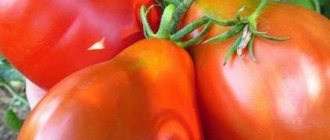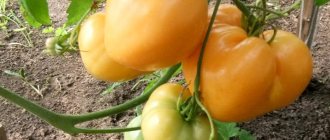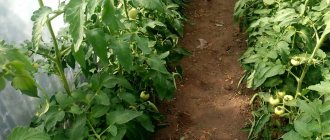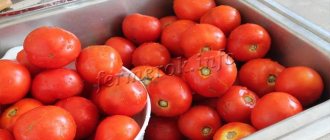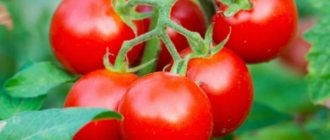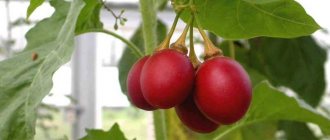Description of the tomato variety Novichok
Initially, the Novichok tomato variety, a photo and description of which is given in the article, was intended for commercial production in agricultural enterprises in the southern regions. It was supposed to be grown in open ground. However, it quickly spread throughout the European part of Russia. They know about the variety in the Urals, Siberia and the Far East. The variety bears fruit well both in open ground and in greenhouses and greenhouses.
The agricultural technology of the Novichok tomato is one of the simplest. This is due to the unpretentiousness of the variety, the short stature of the plants, and the formation of a small number of stepsons. Characteristics and reviews of the Novichok tomato say that it is highly resistant to late blight and other fungal diseases. This reduces the number of treatments and makes maintenance easier. However, the variety is heat-loving and prefers well-fertilized soils.
The variety is determinate and is distinguished by small, compact bushes. The height of the Novichok tomato is 60-85 cm. The plant is not a standard species and produces an average number of shoots. They are powerful, gray-green in color. However, during fruiting they need support. The reason for this is the large number of fruits.
The leaves are medium sized, the usual shape for a tomato. Slightly wrinkled, with pronounced veins. The leaf blades of a healthy plant are dark green in color and have a barely noticeable edge on the back side.
The newbie blooms with medium-sized yellow funnel-shaped flowers. Inflorescences are collected in brushes of 4-6 pieces in one brush. The first brush is usually formed above the 6th leaf. Next, the tomato lays the brushes through 1-2 leaves. By the time of fruiting, the entire tomato bush is covered with fruits.
What ripe beginner tomatoes look like
It is generally accepted that the shape of the fruit of the Novichok tomato resembles “cream”. However, they are more likely to have a spindle-shaped or cone-shaped shape, tapering towards the nose. The stalk exhibits slight ribbing.
The tomatoes are small, with an average weight of 75-100 grams. Housewives like to use these tomatoes for canning. They fit easily into a jar. The color of ripe fruits is bright, red, without a greenish spot at the stalk.
Interesting fact!
Currently, it is possible to grow only the Novichok variety of red tomatoes, but also pink ones. Professionals also know the variety N. De Luxe. They were released in 2006.
The variety has good taste. Their tasting score is 4.6 out of 5. It could be higher, but many people don’t like the thick skin. Novichok tomatoes are fleshy, the number of seeds inside the fruit is small. The fruits are sweet, with slight sourness and a bright aroma.
Harvesting and application
As soon as the tomatoes acquire a bright red color, if they are Novichok, or a bright pink color, if they are the subspecies Novichok pink, as well as an elongated cylindrical shape, they are harvested. As a rule, ripening occurs in July and August.
Pick tomatoes carefully so as not to damage either the branches or the tomato itself. For storage, place the fruits in a box lined with newspaper. Do not put too many tomatoes in one box, as the fruits underneath may become bruised. Store the box in a dry place, but not in direct sunlight. The room temperature should not exceed +6 ºС, otherwise the tomatoes will begin to deteriorate.
If there is a need for long-term storage of tomatoes (more than 3 weeks), remove them from the branches slightly unripe and put them in boxes to ripen in the same way.
The harvest has a wide variety of uses: the fruits are convenient to preserve, they fit perfectly into jars and have an excellent taste after pickling. Fresh Novichok tomatoes will decorate the holiday table even in the form of ordinary slices.
We also shouldn’t forget about the beneficial properties of tomatoes: tomatoes are a powerful antioxidant. Lycopene, which is part of the tomato, helps in the treatment of many diseases. In addition, tomatoes have an antibacterial effect, prevent blood clots, and due to the serotonin they contain, they will lift your mood.
Characteristics of tomato Novichok
The Novichok variety is heat-loving and not frost-resistant. Do not forget that it was developed for the southern regions. When grown in the middle zone, it must be treated with special attention when planting in open ground or a greenhouse. Additional cover may be required.
This disadvantage is more than compensated for by the drought resistance of the variety, which is important for owners of summer cottages who rarely visit their acres. In addition, its immunity to fungal diseases allows it to develop and bear fruit in cool and rainy weather.
The ripening time of Novichok tomatoes is mid-early. Depending on weather conditions, tomatoes ripen in 115-130 days. When grown by seedlings, ripe fruits can be obtained as early as mid-July.
Fruiting is very friendly, which is confirmed by reviews and photos of the Novichok tomato variety in the garden beds. It is for this reason that farmers love the variety. Dense tomatoes with one-time ripening can be harvested mechanically.
Despite the small size of the fruits, the yield of the variety is high. At least 2.0 kg per bush or 14 kg per square meter of area. Thanks to its thick skin and fleshy fruits, the Novichok tomato can be stored for a long time and tolerates transportation well.
Red Tomatoes Novichok are considered universal in use. They are used fresh for making salads. But they are especially good when marinated and salted. The fruits are resistant to cracking, including during heat treatment. Resourceful housewives are happy to use the variety to prepare sun-dried tomatoes for the winter. Tomatoes are also suitable for preparing winter salads and lecho.
"Pros and cons"
Despite the long growing period and the emergence of new varieties, the Novichok tomato still deserves positive reviews not only from owners of small plots of land, but also from farmers who grow tomatoes for sale or for processing. The variety has the following characteristics:
- high productivity;
- drought resistance;
- compactness of low-growing plants;
- unpretentiousness in care associated with the small size of the bushes and the formation of a small number of stepsons;
- high immunity to diseases, including those of fungal origin;
- good taste of tomatoes;
- keeping quality and transportability of fruits without loss of taste and commercial qualities;
- versatility in use;
- When canning and pickling, Novichok tomatoes do not crack and retain their shape.
Advantages and disadvantages
Tomato Novichok pink , like red, has the same advantages:
- Fast and simultaneous ripening of fruits.
- Stable and reliable yield.
- Easy to care for.
- Resistance to diseases is inherent in this culture.
- Long shelf life of fresh tomatoes.
- Resistance to transportation.
- Versatility.
- They practically do not overripe and do not crack.
Flaws
The Novichok variety has no obvious disadvantages. However, some gardeners consider the smooth ripening of fruits not an advantage, but rather a disadvantage, since they want more extended fruiting.
Planting and care
In the southern regions, Novichok is planted with seeds in the ground. Thanks to the relatively early ripening period, it has time to ripen. In the middle zone, preference is given to growing by seedlings.
Growing tomato seedlings Novichok
Novichok tomato seeds are sown for seedlings in mid-March if you plan to grow tomatoes in a greenhouse, and at the end of the first spring month if planting in open ground is planned.
The seeds have good germination and are not particularly demanding on the composition of the soil. Most vegetable growers prefer to use commercial soil mixture. Those who prefer to prepare it themselves will have to mix garden soil, soil from the area where they plan to plant tomatoes, compost or humus in equal parts. To make the soil loose, add wood ash, sand, vermiculite or steamed coconut fiber. The prepared soil is disinfected with a boiling solution of bright-colored potassium manganese.
Attention!
Tomato Novichok is a variety. If the seeds were collected independently last season, then it is worth checking their quality and treating them against fungal infections.
Seeds are planted in containers on compacted and well-moistened soil. Scheme for planting tomatoes Novichok 1*3 cm. The crops are mulched with a mixture of peat and soil, moistened abundantly and covered with glass or covered with film. The first shoots should appear in 4-7 days.
With the appearance of sprouts, the shelter is removed and the containers are transferred to a well-lit place. Tomato seedlings need:
- timely watering, but do not over-moisten the soil;
- picking in separate cups with the appearance of 2-4 true leaves;
- feeding with complex fertilizers such as “Krepysh”, “Ecosil”, “Zircon” or “Kornevin”;
- in additional lighting if necessary;
- in hardening off plants before planting in the ground.
By the time of transplantation, the age of the seedlings should be 55-65 days, and the plants themselves should have 6-10 true leaves and a strong fleshy stem.
Transplanting a Novichok tomato into a greenhouse or into the ground
To grow Novichok tomatoes, choose well-lit places with light, well-fertilized soils. When cultivating the variety in open ground, the areas must be protected from cold winds.
Preparations for planting begin in the fall. The area is dug up and rotted compost or humus is added. On heavy soils use sand or sawdust. Plots of land with acidic soils are sprinkled with wood ash or dolomite flour.
Attention!
Experienced gardeners recommend sowing mustard in greenhouses to renew and loosen the soil. In addition, it also has an excellent disinfectant effect, the ability to destroy pathogenic spores of fungi and bacteria.
In the spring, Novichok tomatoes are planted in holes. A small amount of soil mixed with humus, wood ash and superphosphate is added to the bottom. The plants are removed from the containers, planted on the prepared mixture, and covered with soil. If the tomato stems are stretched out, you can deepen them a little. Plantings are watered and mulched abundantly.
Bush care
Caring for seedlings is simple and consists of timely watering, periodic loosening of the soil, tying up the stems, and fertilizing. For bushes of this variety, it is important to carry out pinching - regular removal of stepsons (weak side shoots). After pinching, the central stem is pinched above the upper inflorescence.
Expert opinion
Stanislav Pavlovich
A gardener with 17 years of experience and our expert See also Description and subtleties of growing tomato Striped chocolate
Ask a Question
This is done throughout the entire development cycle of the plant. At the same time, thin out the crown, removing excess leaves and empty inflorescences.
Watering
The regularity of watering Novichok tomatoes is determined based on the weather, preventing the soil from drying out. Irregular watering will lead to a lack of harvest and deterioration in the quality of the fruit. Insufficient watering will make the fruits less juicy. In the hot season they are watered in the evening, and in cool weather - in the morning. Watering with cold water should not be allowed. When watering, avoid getting water on the leaves; try to spray the water using the irrigation method so that it is all evenly moistened.
Top dressing
Fertilizing is done after watering, while the soil is still wet, in the evening.
To feed tomatoes of the Novichok variety, complex mineral fertilizers with a quick-acting effect containing nitrogen (ammonium nitrate), phosphorus (superphosphates), and potassium (potassium salt) are used. Organic fertilizers include bird droppings, manure, herbal and nettle infusions. After fertilizing, the plants are again well watered.
During the summer, 3 feedings are done:
- 2 weeks after planting tomatoes (to grow tops), apply nitrogen fertilizers;
- after another 2 weeks (with the beginning of the flowering period) – complex fertilizer “Kemira Lux”;
- after another 2 weeks (at the beginning of the fruiting period), Kemira Lux fertilizer is re-applied (1 tbsp per 10 liters of water).
If the weather is rainy, then add dry microelements (3 g ammonium nitrate + 5 g superphosphate per 1 square meter of soil).
Expert opinion
Stanislav Pavlovich
Gardener with 17 years of experience and our expert
Ask a Question
Foliar feeding is also carried out with an aqueous solution of borax or boric acid (1 g per bucket).
Mulching and loosening
To evenly moisten the soil, after each watering the beds are loosened. 2 weeks after planting tomatoes of the Novichok variety, the surface of the beds is mulched using fresh or dry grass, sawdust, and buckwheat husks. Mulch, reacting with the soil, takes microelements from it. To make up for the deficiency, sawdust for mulching is mixed with ash, and after the procedure, the beds are watered with a urea solution at the rate of 2 tablespoons per 10 liters of water.
Bush formation
When forming bushes of the Novichok variety, two stems are left (the main stem and the most powerful stepson). Weaker stepchildren are regularly pruned off when they reach a height of 5–7 cm. Too thick crowns are thinned out, exposing the ovaries to the sun.
Garter
After the end of the flowering period, the stems are tied to previously installed pegs. This is done as needed, when, under the weight of the ovaries, the stem begins to bend down and the ripening fruits end up lying on the ground.
Pest and disease control
The Novichok variety is resistant to the vast majority of diseases and garden pests. But to completely eliminate the risk, regular preventive measures are necessary. This is especially important for mass industrial cultivation of vegetables.
Interesting! Tomato plantings should not be placed next to potato beds, as these vegetables have common diseases. It is recommended to plant tomatoes where there were previously beds of onions, cucumbers, carrots, and cabbage.
The following preventive measures are carried out:
- to protect against fungal diseases, spray the plants with a solution of trichopolum (6 tablets per 10 liters of water);
- to protect against late blight, use a solution of the drug XOM (copper chloride) (40 g per 10 l of water);
- white spotting is eliminated by removing the affected leaves, the plants are sprayed with copper oxychloride or the preparation “Horus”;
- to protect against spider mites, use a solution of onion peels (200 g per bucket of water);
- the Colorado potato beetle is combated using a special mixture (0.5 kg of wormwood is mixed with a glass of ash and a tablespoon of laundry soap, infused in hot water);
- To combat the mole cricket, they use the drug “Thunder”, spreading granules in its nesting areas.
For this variety, it is recommended to use safe preparations, the use of which will not affect the quality of the fruit (phytosporin, trichodermin, boric acid).
How to grow tomatoes Beginner
Caring for Beginner tomatoes is not difficult. They need watering, weeding, loosening the soil, fertilizing and forming bushes.
- Watering is carried out no more than 2 times a week at the root in the early morning or evening hours. For irrigation, use warm, settled water. If tomatoes growing in a greenhouse are watered in the evening, do not close it immediately. Allow to ventilate for 0.5-1.0 hours.
- The first fertilizing is carried out two weeks after transplantation; it is advisable to use organic fertilizers. In the future, 2-3 more feedings are carried out using complex fertilizers.
Tomatoes also need pinching and bush formation.
Features of growing tomato
There are no difficulties with sowing and caring for these tomatoes; it is not without reason that they are recommended for beginning gardeners. In most regions of the country, seedlings are first grown, and only then the seedlings are planted in beds or in shelters.
According to reviews from experienced gardeners and novice summer residents, the “newbie” shows high productivity in the open air. The characteristics of the variety indicate that in regions with a harsh climate it is advisable to play it safe and cover the bushes after planting with non-woven material or film.
Diseases and pests
Novichok tomatoes have high immunity to diseases. And their friendly and fairly early ripening makes them practically invulnerable to late blight. However, preventive treatment of plants with fungicides should not be neglected. Especially if the weather is cool and damp.
Of the pests, tomatoes are threatened by the mole cricket. A large insect damages the roots and stems of plants. It can only be combated by mechanical or chemical means. To prevent the appearance of pests in greenhouses, they try to keep them clean and do not create compost heaps or near them.
Reviews from netizens
ADVANTAGES: Germination, plant height, resistance to temperature conditions, active flowering and ovary. DISADVANTAGES: None found yet. Good day to all! I’m not a farmer, not a gardener or gardener) I’m just learning) This year I randomly took the first bag of tomato seeds I came across, I was attracted by the photo and description. The germination of the seeds turned out to be 100%, I did not count on this and was a little shocked. My seedlings were what is called “dead”, because the sun is up to 11, and the daylight is obscured by the tree crowns. I soaked the seeds in a wet cloth the old fashioned way and left them until the morning. Planted in the second half of April. I know it’s late :), but before the weather was not sunny, so buy special ones. I didn't want a lamp. There was no hope of success, but since they had arrived, it was decided to disembark. The strongest specimens are in the greenhouse, the rest are in open ground. In the greenhouse, the soil is manured and quite loose. Open ground - mostly sand. I added manure and forest humus soil to each hole. I water both beds with regular water, once a month with infused manure and vermicompost from the store. Since the planted bushes were stunted in growth, they bloomed a week later than their brothers (my mother grew brothers of a different variety on her 6th floor with south-facing windows). There are many flower stalks. The fruits set without problems, they didn’t even spray the ovaries. Tomato “newbie” is medium-sized. They promise us no more than 90 cm. This is a plus, since other varieties (the “cascade” and “thumbelina” grow nearby already rest against the roof of the greenhouse, in the places of the slope). “Newbie” tomato on the day the review was written: In a greenhouse it is about 80 cm, and in open ground it is about 60 cm. The leaves are as powerful as those of an elite varietal potato, and the trunk reaches a thickness of 1.5 fingers (in the greenhouse). The lower side shoots grow with incredible strength and tenacity. I'm tired of taking care of them, but I have to! Otherwise, the plant will spend all its energy on their growth and development, and not on fruit formation. As soon as the time comes to harvest tomatoes, I will definitely add statistics on the number of fruits collected from one bush, grown in different conditions. Your impressions of the taste, quality and storage of fruits. And then I will adjust my estimates if necessary. So, lady statistics: The number of tomatoes per bush in a greenhouse: 40, outside 20-25. Ripening in a dark, cool place is excellent; the outdoor ones are a bit affected by late blight. Storage: keep in a warm place for 2-3 weeks, then the skin wrinkles a little, in a cool place - excellent. Taste: I like it. The skin is chewy :), the tomato is not fleshy, sweet, easy to cut into rings. Have a fruitful autumn everyone! Be it the anticipation of the harvest, the implementation of plans, the implementation of ideas!
SKLana
https://otzovik.com/review_3501403.html
Expert answers
How to form tomato bushes Novice
Forming a tomato bush Novichok is carried out in 2-3 stems, leaving strong shoots under the first bunch of tomatoes. At the moment of fruiting, supports are organized. The tomato does not need to be pinched at the top, since the variety is determinate.
Is it necessary to plant a tomato Novichok?
Growing tomatoes for a beginner will not take much time from vegetable growers. The plant is not prone to forming stepsons. If they appear, it is at the lower levels. Excess sprouts are carefully broken off with your hands, leaving stubs of 3-5 cm.
Growing seedlings yourself
The variety is not particularly difficult in terms of agrotechnical measures. In warm areas of the country, it can be planted by direct sowing of seeds in open ground. But in most cases, these tomatoes are obtained during the preliminary stage - growing seedlings.
Did you know? Eating tomatoes, rich in serotonin (the hormone of happiness) and thiamine (an anti-neuritis vitamin), has a calming effect on the body during stress.
Sowing time
In order to be able to transplant seedlings into open ground within the recommended time frame, Novichok seeds are sown around the twentieth of March. The seedlings must be two months old at the time of placing them in open ground.
The soil
To sow seeds, the soil is specially prepared several days in advance. For this purpose, sand, turf and peat soil are mixed with the addition of rotted fertilizer, compost, and wood ash. If it is not possible to prepare the soil mixture yourself, a commercial ready-made mixture enriched with nutrients is quite suitable. It would be a good idea to disinfect the prepared soil by pouring boiling water and a weak solution of potassium permanganate on it a couple of days before sowing.
Important! Due to the possibility of causing rapid growth of green mass and the appearance of pathogens, it is not recommended to add fresh manure to the soil.
Growing container
Suitable options for containers for obtaining seedlings are wooden boxes or plastic containers. Separate plastic cups and other devices are often used. They should first be disinfected with a solution of potassium permanganate.
Seed preparation
An experienced and knowledgeable vegetable grower will always check the seeds before sowing and process them correctly. To test tomato seeds intended for sowing, they need to be immersed in a five percent salt solution for a couple of tens of minutes. Suitable and viable specimens will fall to the bottom, while unsuitable ones will remain on the surface of the solution.
Specimens that have sunk to the bottom must be washed and dried. Then they need to be disinfected for at least half an hour in a rich pink solution of potassium permanganate, after which they are washed again with clean water and dried. Next, it would be useful to carry out the procedure of hardening the seed material: it is placed in a moistened cloth, wrapped and placed in the refrigerator for a couple of days, or alternate stays in the refrigerator and a warm place (12 hours each).
Important! Soaking in solutions of salt and potassium permanganate helps to disinfect the seeds and completely destroy pathogenic spores on them, if there were any. In addition, this procedure helps stimulate germination and feed the seeds.
The seed must be completely dry or germinated before sowing. To germinate seeds, they should be wrapped in a wet cloth and left in a warm place for some time until white shoots appear, after which they are ready for sowing.
Sowing seeds
Dried hardened or sprouted seeds are placed in prepared soil, poured into a container in a layer of up to 6 cm. It is recommended to carefully grasp the sprouted seeds with tweezers to avoid damage to the roots.
Seeds are immersed in moist soil to a depth of 1–1.5 cm. The distance between each specimen should be from 2 to 3 cm.
Seedling care
The container with the sown seeds is covered with film or glass on top for the rapid appearance of sprouts. The temperature in the room is maintained at +21–24 °C until germination. The room must be sufficiently illuminated.
As soon as the shoots appear, the cover must be removed and the room temperature reduced to +16 °C. To ensure uniform development of plants, they should be rotated regularly. Temperatures above +18 °C and insufficient lighting have a detrimental effect on the emerging sprouts; they begin to weaken. It is recommended to water the seedlings when the top layer of soil noticeably dries out. Watering combined with mineral fertilizing will bring great benefits. But if the soil was initially nutritious, then it does not need additional fertilizing. The benefit comes from foliar feeding by spraying wood ash on the bushes.
Important! Dried soil poses less of a danger to Novichok seedlings than waterlogged, swampy soil.
Seedlings should be watered abundantly only 4 times: when sowing seeds, when they germinate, when taking the first leaf, and before picking. In any case, you need to ensure that water does not stagnate.
As soon as a few leaves appear on the seedlings, it is considered ready for picking. It is absolutely necessary to carry it out. It is recommended to pinch the main root to ensure the development of strong roots on the sides.
Hardening of seedlings
7–10 days before planting in open ground, the seedlings begin to be watered less and are taken out to the balcony or veranda for a short time, gradually increasing the time they stay there. The next stage is to constantly keep the plants outside. After such manipulations, the seedlings are considered ready for transplanting into the garden.
Did you know? The weight of a wild tomato can be no more than 1 g, and a cultivated fruit can weigh over 1 kg.
Planting seedlings in a permanent place
In areas where Novichok is recommended for productive cultivation, it is optimal to safely plant its seedlings in open soil at the end of May.
Planting seedlings depends on the climate of the area where it is produced, as well as the conditions in which the seedlings are placed - greenhouse or unprotected space. The main thing when planting begins is that the threat of frost disappears. Novichok is planted in greenhouses at the end of spring; it is best to plant it in open soil in mid-June.
This is usually done when the seedlings are two months old from the day the seeds were sown. Stocky plants with thick stems no higher than 30 cm without formed flower clusters are excellent for replanting.
Seedlings are planted at the rate of up to seven plants per 1 square meter. m area, in a checkerboard pattern at a distance of 40 cm between the bushes. Between the rows you should maintain a slightly larger distance, up to half a meter.
Pre-dug holes for planting should be watered abundantly. If the seedlings have remained compact, then they should not be deepened too much, but if they have grown larger than they should, then they should be buried almost to the leaves. It is enough to water the planted seedlings and mulch the ground around it with dry soil, grass, and rotted residues.
We recommend reading how to properly store tomatoes at home.
Reviews from gardeners about the Novichok tomato
Olga, 32 years old, Novocherkassk I have been growing the Novichok tomato for a long time. I really like it marinated or salted. Strong tomatoes with great taste. And also for friendly maturation. One moment and my preparations for the winter have already been made.
Yulia, 41 years old, Lipetsk The Novichok tomato may not have an amazing taste. Although for me there is enough juiciness and sweetness. But you can always count on an excellent harvest, which does not depend on the vagaries of the weather. It is good fresh. When rolled up, it retains its shape and the skin does not crack. We tried drying. Excellent for these purposes too.
Comparison with other varieties and hybrids for pickling and salting
Not all tomatoes are suitable for canning. If you plan to harvest for the winter, it is recommended to carefully select seeds. Primary requirements:
- light weight;
- dense pulp and skin;
- amicable maturation;
- a small amount of seeds, preferably small ones.
In terms of parameters, the “novice” tomato is an ideal choice for canning, but not the only one. The comparative table shows descriptions and main characteristics of tomatoes, intended, like the “novice”, mainly for preservation.
| Name | Category, type | Height (cm) | Ripening time | Fruit characteristics |
| Sanka | Variety, determinate | 60-70 | Early ripening | Round, very dense, weigh 80-100 g. Color - red |
| Caspar F1 | Hybrid, determinate | 80-100 | Early ripening (90-95 days) | Pepper-shaped, with a “spout”, dense. Great taste. Color - bright red. Weight - 110-140 g |
| Fun | Variety, determinate | 60-70 | Early ripening | In the shape of an ellipse (length up to 14 cm), with a bifurcation at the top. Color - bright red, weight - 110-150 g |
| Rio Grande | 55-65 | Mid-season | Oval, plum-shaped, weighing 100-110 g. Color: pinkish-red | |
| Scarlet candles | Variety, indet | 180 | Mid-season | Elongated, with a “spout”, dense. Glossy skin, weight - 90-100 g |
| Yesenia F1 | Hybrid, determinate | 60-70 | Ultra early | Round, dense, dark red. Weigh 120-140 g |
| Baskak | Variety, determinate | 80-100 | Mid-early | Ovoid, slightly ribbed. Color - red. Weight - 60-90 g |
| Zlatozar F1 | Hybrid, determinate | 50-60 | Ultra early (80-85 days) | Round, orange in color, weigh 80-100 g |
| Ramsay F1 | Hybrid, indet | Early ripening | Round, bright red. Weight - 120-140 g | |
| Lady fingers | Variety, determinate | 60-70 | Early ripening | Cylindrical, two-chamber, weigh 50-70 g. Color - rich red |
| Cadet | 40-50 | Early | Elongated, with glossy skin, red. Weight - 50-60 g | |
| De barao (red) | Hybrid F1, indet | 200-250 | Mid-late | Plum-shaped, dense, bright red. Weight - 80-90 g |
Resistance to diseases, insect attacks
Important!
The variety is resistant to diseases, the bushes are not affected by brown spotting or root rot.
To prevent fungal diseases, treat tomatoes with Trichopolum solution by pouring 5-6 tablets into a ten-liter bucket of water. Then pour a glass of milk into the bucket and spray the plants.
If you see dark spots on the fruits, this means that the tomatoes have become ill with the most common disease for these plants - late blight. At the same time, treat the bushes with Tattu.
If the plants have been attacked by mole crickets, then finely chop the dried marigolds and sprinkle them on the ground near the bushes. For ticks and aphids, use elderberry infusion, tobacco powder, garlic infusion, and chamomile infusion.
To combat cutworms and naked slugs, make an infusion of hot peppers and spray the plants with it. You can make an infusion of large burdock or wild garlic.
If you plant parsley or dill along the perimeter of the beds, then Colorado potato beetles will not be able to reach the plantings.
Advantages of the variety
Advantages:
- The fruits ripen almost simultaneously.
- The variety is resistant to diseases.
- Tomatoes are easy to transport as they are resistant to overheating and cracking.
- They can be planted both on the site and in a greenhouse.
Maturation speed
The variety is classified as mid-early. After planting the seedlings, approximately 53-56 days pass until harvesting, and 110-127 days pass from the emergence of seedlings to harvesting the tomatoes.
The main purpose of the variety
The fruits have an excellent presentation, they are sweet, so they are eaten fresh and added to salads. Sauces are made from them and juice is squeezed out. The fruits are almost the same size, so they are canned whole, salted, and pickled.

